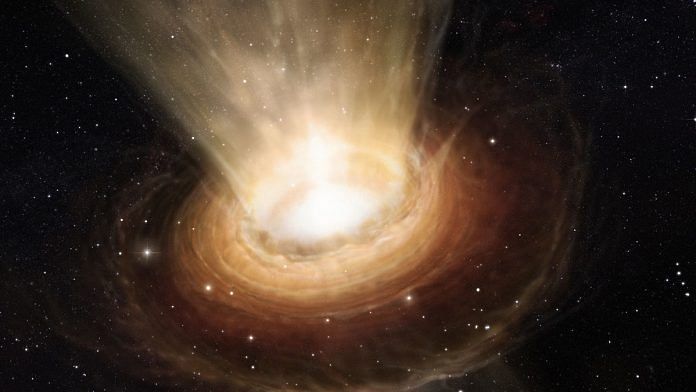Supermassive black hole missing in distant galaxy, says NASA
The disappearance of a supermassive black hole — estimated to weigh between 3 billion and 100 billion times the mass of the Sun — has left scientists perplexed.
Despite searching with NASA’s Chandra X-ray Observatory and Hubble Space Telescope, astronomers have no evidence of the black hole, which should have been present in an enormous galaxy located about 2.7 billion light years from Earth.
Nearly every large galaxy in the universe contains a supermassive black hole at its centre, with a mass that is millions or billions of times that of the Sun.
Astronomers expected this galaxy, at the centre of a cluster known as Abell 2261, to contain a supermassive black hole. But data obtained in 1999 and 2004 did not yield signs of such a presence. Fresh observations too have failed to locate any such black hole.
Researchers are now considering alternative explanations, such as the black hole being ejected from the host galaxy’s centre. The James Webb Space Telescope — scheduled to be launched next year — might be able to find this missing supermassive black hole. More on Futurism.
Moon plays a role in releasing trapped methane from Arctic seafloor, says study
It is well known that the Moon’s gravitational pull influences the tides that shape the coasts on Earth. Now, a new study suggests that these tides also significantly affect the intensity of methane emissions from the Arctic Ocean seafloor.
The Arctic leaks enormous amounts of methane, a potent greenhouse gas. These leaks have been going on for thousands of years, but in a warming world, the phenomenon may intensify.
Once this trapped methane escapes the ocean floor and enters the atmosphere, it further contributes to global warming. The total amount of methane in the atmosphere has increased immensely over the past few decades. Some of this rise can be ascribed to human activity, but this study has revealed that even the Moon has a role to play.
Gases accumulated in the sediments within a metre from the seafloor are vulnerable to even slight pressure changes in the water column. The study could have serious implications for climate research. More on Livescience.
Also read: 31 species extinct, all freshwater dolphins threatened — IUCN releases updated Red List
In a first, radio bursts detected from a distant planet
For the first time, scientists have detected radio bursts emanating from the constellation Boötes. This could be the first radio emission collected from a planet beyond our solar system, though the researchers from Cornell University believe that the radio signals are emissions by the planet itself.
The Tau Boötes system contains a binary star and an exoplanet located 51 light years away. If confirmed through follow-up observations, this radio detection gives scientists a new way to examine distant planets. The team has already begun using multiple radio telescopes to follow up on the signal from Tau Boötes. More on Space.
Hundreds of endangered seals found dead on Caspian Sea shores
Russia is investigating the mysterious death of hundreds of endangered seals, discovered on the shores of the Caspian Sea.
Since last week, 272 dead Caspian seals have been found at a number of locations in the country, and authorities are expecting to find more. The Russian fisheries agency said an “infectious disease” could be behind the deaths, but an animal abuse probe would also be launched.
The Caspian Sea, the world’s largest inland body of water, is bounded by five countries: Russia, Kazakhstan, Azerbaijan, Iran and Turkmenistan.
Seals are endangered due to over-hunting and industrial pollution in the sea. There are now only 70,000 Caspian seals left, down from over a million in the early 20th century. More on The Moscow Times.
Furry dinosaur with strange keratin ribbons discovered
Scientists have discovered a chicken-sized, furry dinosaur that lived about 110 million years ago in what is now Brazil. The dinosaur made a living hunting insects and perhaps small vertebrates like frogs and lizards.
The team described this dinosaur as one of the strangest it has come across. It possessed a mane of hair-like structures along with two stiff, ribbon-like features protruding from its shoulders. These ribbons were possibly made of keratin — the same substance that makes up human hair and fingernails.
The scientists said they have never encountered such ribbon-like structures before. They may have been used for display, possibly to attract mates or intimidate enemies. More on The Guardian.
Also read: The 6 pests coming to eat our crops, thanks to climate change



